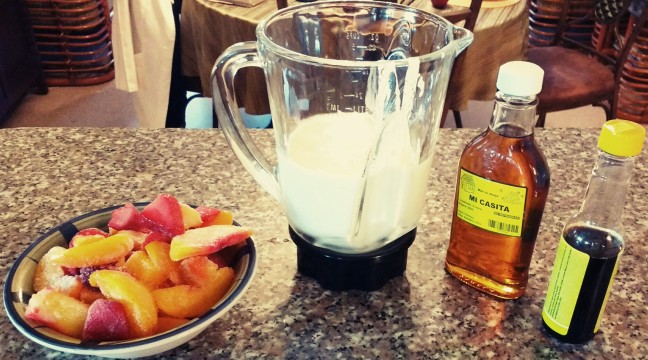In a few posts I’ve written about the importance of trying to avoid processed and packaged foods, as they tend to contribute higher amounts of sodium, added sugar, and artificial ingredients. Some of the most commonly used processed/high sodium foods used in the home are store-bought sauces, especially salad dressings, tomato sauce, and dips. Today I’m going to share 3 great recipes for sauces you can easily make at home: you never have to use store-bought sauces ever again!
First up, a great vinaigrette (of course, adapted from an awesome Mark Bittman recipe) to dress up any salad — makes about 3/4 cup, 177mL, or about 12 servings. All you’ll need is:
- 1 teaspoon mustard (preferably Dijon)
- 3 tablespoons any vinegar
- 1/2 cup (118 mL) Olive oil
- Salt (try and keep it under 2 teaspoons) and pepper to taste
- Throw everything in a jar or container with a tight sealing lid, and shake vigorously until well combined.
Easy, tasty and healthy — each serving has less than 100 calories and about 400mg sodium. You can vary this basic recipe in a million ways. Try different kinds of vinegar; add 1-2 teaspoons of honey or orange juice for a sweet flavor; add a tablespoon of chopped garlic, onion, or ginger; add 1-2 teaspoons of any chopped herbs; add 1 teaspoon soy sauce (instead of salt) or a bit of sesame oil for asian flavors; use lemon or lime juice instead of vinegar; add 1-2 tablespoons yogurt or grated parmesan cheese for creaminess. This basic vinaigrette can at least a week in your fridge (depending on what fresh ingredients you might add), and if it separates you can just re-shake the jar before serving.
Next up, Mark Bittman’s fantastic recipe for homemade marinara sauce (makes about 3 cups or 4-6 servings).
- 2-3 tablespoons olive oil
- 4 cups diced tomato (or #2 15oz/444mL cans)
- 1 medium onion, chopped
- ½ cup (118mL) grated parmesan cheese
- Salt (try and keep it under 1 teaspoon) and pepper to taste
- ½ cup fresh (or 2-3 tablespoons dried) chopped herbs if desired
- Heat the olive oil in a skillet over medium-low heat, when hot add the chopped onion. Cook, stirring every minute or so, until the onions are soft (about 3-4 minutes).
- Add the diced tomato and salt and pepper and combine. Bring this to a boil, then adjust the temperature to leave everything at a steady simmer. As you let this cook, stirring every few minutes, everything will start to break down and you can break apart the tomato and onions a bit in the pan with your spoon. Continue to simmer until the sauce gets thick (no watery liquid in the pan), about 20 minutes total.
- When the sauce is nice and thick, add the grated parmesan cheese and the herbs (if you’re using them) and stir until well combined.
Each serving contains less than 10g fat, around 150 calories, and about 500mg sodium. This is another versatile recipe that can be doctored in many ways for different meals. Use any herb you like — basil and oregano work especially well. For a veggie loaded version throw in 1-2 cups spinach/zucchini/mushrooms with the onion; brown 1 lb (440g) ground meat in your skillet before adding the onions for a meat sauce; simmer squid or shrimp or tuna in the finished sauce for a great seafood meal; poach eggs in this sauce for breakfast; throw 1-2 cups of the sauce on some roasted vegetables, top with grated parmesan cheese, and bake for an easy vegetable parmesan; serve this on your favorite whole grain pasta; use this on a whole wheat baguette with cheese and your favorite vegetable topping for homemade french bread pizza. This sauce is much more delicious than store-bought sauce, and it couldn’t be easier to make!
Finally, I’ll share this easy recipe, adapted from Jamie Oliver’s website, for Tzatziki (greek-style yogurt sauce, 6-8 servings). All it takes is:
- 1 cup (236 mL) Plain yogurt (you can use greek yogurt if you want a thicker sauce/dip)
- 2-3 tablespoons chopped fresh spearmint
- About 1 tablespoon lime/lemon juice (juice of about half a lime)
- 2-3 teaspoons chopped garlic cloves
- Salt (stay under 3/4 teaspoon) and pepper to taste
Whisk everything together and store in the fridge (up to a week or so, but trust me it will be gone before then).
This is a very refreshing sauce that works as a dip for vegetables or bread, can top off a nice chopped salad, adds bit of zing to a sandwich or wrap, and is even fantastic over eggs and toast for breakfast. Make this at least a few hours ahead before serving if you can, as the flavors meld really nicely after some time in the fridge. This is pretty healthy, low-fat stuff — under 40 calories and less than 2 grams of fat per serving — and I defy you to find any store-bought ranch dressing anywhere near as tasty! You can also vary this with different herbs (like oregano or parsley) or extra spices (like a bit of smoked paprika or cumin).
I really hope you all will give these sauces a try — cooking real, healthy food at home can actually be pretty easy when you give it a shot!




